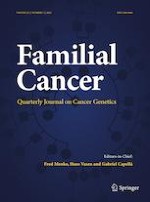Erschienen in:

02.06.2022 | Original Article
Prevalence and risk factors of barrett’s esophagus in lynch syndrome
verfasst von:
Natalie Farha, Ruishen Lyu, David Liska, Amit Bhatt, Carole Macaron, Carol A. Burke
Erschienen in:
Familial Cancer
|
Ausgabe 1/2023
Einloggen, um Zugang zu erhalten
Abstract
Lynch syndrome (LS), the most common hereditary cause of colorectal cancer, predisposes to upper gastrointestinal neoplasia. The prevalence of Barrett’s esophagus (BE) is elevated in some hereditary gastrointestinal cancer syndromes but has not been systematically evaluated in LS. We assessed the prevalence of BE, BE-related dysplasia, esophageal adenocarcinoma (EAC), and factors associated with BE in LS. Asymptomatic patients with a germline pathogenic variant (PV) in the DNA mismatch repair (MMR) genes undergoing EGD for LS surveillance were identified from a hereditary colorectal cancer registry. We assessed the prevalence of BE and compared demographic, clinical, and endoscopic factors in LS patients with and without BE by logistic regression analysis. 323 patients were included. 21 patients (6.5%) were diagnosed with BE including 38% of females and 33% without gastroesophageal reflux disease (GERD). Dysplasia was diagnosed in two patients (9.5%) and EAC in one (4.8%) patient. Factors associated with BE included male gender (OR 3.00, 1.21–7.46), age at last LS EGD (OR 1.04, 1.01–1.08), presence of hiatal hernia (OR 20.09, 4.57–88.23), hiatal hernia > 3 cm (OR 11.25, 2.41–51.94), and GERD (OR 3.39, 1.32–8.67). No MMR PV was associated with BE. BE was diagnosed in 1 of 15 patients undergoing EGD surveillance for LS and nearly 10% had dysplasia including one EAC. Risk factors associated with BE in LS are similar to those established for BE in the general population. More studies are needed to evaluate if an association between BE and LS exists.